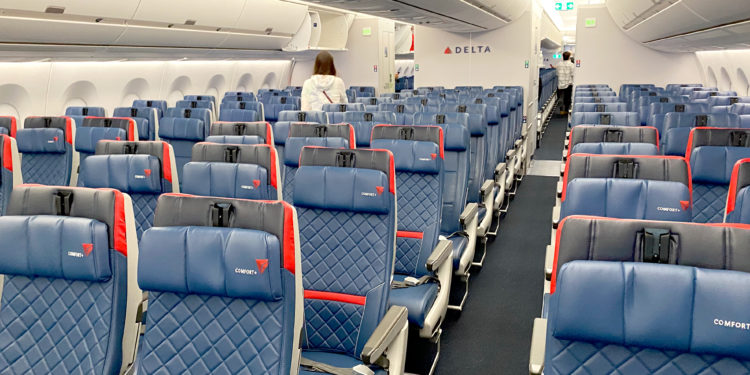Advertiser Disclosure: Eye of the Flyer, a division of Chatterbox Entertainment, Inc., is part of an affiliate sales network and and may earn compensation when a customer clicks on a link, when an application is approved, or when an account is opened. This relationship may impact how and where links appear on this site. This site does not include all financial companies or all available financial offers. Opinions, reviews, analyses & recommendations are the author’s alone, and have not been reviewed, endorsed, or approved by any of these entities. Some links on this page are affiliate or referral links. We may receive a commission or referral bonus for purchases or successful applications made during shopping sessions or signups initiated from clicking those links.
How much do we really want to know about those airline seats we occupy when flying?
A fascinating video produced by CNBC’s Erin Black, Jeniece Pettitt, Shawn Baldwin, and Alex Wood details what happens when airlines retrofit their seats.
And some of the work isn’t pretty.
Carriers may send in some of their aircrafts’ seats every five to eight years. And a lot of gunk ends up in the nooks and crannies: spilled soda, hair, years-old food, and other things. Latitude Aero, a company featured in the video, says it removes around two to three pounds of dirt per seat during a refurbishment.
A few tidbits I found especially interesting:
- Most of their business comes from airlines acquiring other carriers’ planes (hello, Delta!)
- The average seat’s maintenance manual is between 800 and 1,000 pages (as long the Ikea folks didn’t write them…)
- Some seat retrofits cost up to $100,000!
- Shout-out to Europe: because the EU will require all new phones to be powered by USB-C, more and more airlines are incorporating the USB-C ports as part of their in-seat electrical features.
The video is embedded below. You can also view it here.
Advertiser Disclosure: Eye of the Flyer, a division of Chatterbox Entertainment, Inc., is part of an affiliate sales network and and may earn compensation when a customer clicks on a link, when an application is approved, or when an account is opened. This relationship may impact how and where links appear on this site. This site does not include all financial companies or all available financial offers. Opinions, reviews, analyses & recommendations are the author’s alone, and have not been reviewed, endorsed, or approved by any of these entities. Some links on this page are affiliate or referral links. We may receive a commission or referral bonus for purchases or successful applications made during shopping sessions or signups initiated from clicking those links.












I’m not sold on usb c. Those plugs always feel loose in my opinion.
Not sure what you’re plugging into but I’ve never had an issue. Sure as sure I will now!
Sold or not, it’s the mandated connector type in the EU. For manufacturing efficiency, companies will adopt a single connector type for all of their products . . . even appliances.
My smartphone from 2019 has USB-C and it is loose. To charge, I must place the phone on a surface completely undisturbed and not even touch the cord or the connection may not hold.
My previously phone lasted 4 years. The one before 3 years. I am hoping for at least 5 years, even 6 years from the current phone. My flip phones lasted much longer than that and were still functional when I got rid of them. I have a 40 year old landline from my parents that still works. That is the green and environmentally sound way, things that last.
You may want to replace the cable with a higher quality one. Or it could be your connector port is dirty.
There should be no reason those seats should cost up to $100K. I’d like to see a cost breakdown of labor, material and certifications. There is something majorly inefficient going on.
In the video, they seem to reference the ultra high-end products in Emirates, etc.
Everything in aviation costs, 3 or 4X what it does on the ground. Boats are close to this multiple. The airlines don’t care because guess who pays for this stuff? You.
Sorry but I was more focused on the 2-3 pounds of dirt per seat… yuck !
Right? Like, how is that even possible?
Wait. Maybe I don’t want to know.
…it was the “and other things” in the seats that he mentioned, which has me really worried. I think I am wearing a disposable onsie the next time I board. I might add a gas mask too.